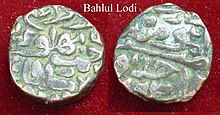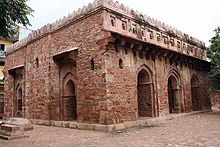
Muslim period in the Indian subcontinent is conventionally said to start in 712, after the conquest of Sindh and Multan by the Umayyad caliphate. It began in the Indian subcontinent in the course of a gradual conquest. The perfunctory rule by the Ghaznavids in Punjab was folllowed by Ghurids, and Sultan Muhammad of Ghor (r.1173–1206) is generally credited with laying the foundation of Muslim rule in Northern India.

The Delhi Sultanate, or the Sultanate of Delhi, was an Islamic empire based in Delhi that stretched over large parts of the Indian subcontinent during the period of Medieval India, for 320 years (1206–1526). Following the invasion of South Asia by the Ghurid dynasty, five unrelated heterogeneous dynasties ruled over the Delhi Sultanate sequentially: the Mamluk dynasty (1206–1290), the Khalji dynasty (1290–1320), the Tughlaq dynasty (1320–1414), the Sayyid dynasty (1414–1451), and the Lodi dynasty (1451–1526). It covered large swaths of territory in modern-day India, Pakistan, and Bangladesh as well as some parts of southern Nepal.

Ibrahim Khan Lodi was the last Sultan of the Delhi Sultanate, who became Sultan in 1517 after the death of his father Sikandar Khan Lodi. He was the last ruler of the Lodi dynasty, reigning for nine years until 1526, when he was defeated and killed at the Battle of Panipat by Babur's invading army, giving way to the emergence of the Mughal Empire in India.

The Sayyid dynasty was the fourth dynasty of the Delhi Sultanate, with four rulers ruling from 1414 to 1451. The first ruler of the dynasty, Khizr Khan, who was the Timurid vassal of Multan, conquered Delhi in 1414, while the rulers proclaimed themselves the Sultans of the Delhi Sultanate under Mubarak Shah, which succeeded the Tughlaq dynasty and ruled the Sultanate until they were displaced by the Lodi dynasty in 1451.

Lodi Gardens is a city park situated in New Delhi, India. Spread over 90 acres (360,000 m2), it contains Mohammed Shah's Tomb, the Tomb of Sikandar Lodi, the Shisha Gumbad and the Bara Gumbad, architectural works of the 15th century by Lodis - who ruled parts of northern India and Punjab and Khyber Pakhtunkhwa province of modern-day Pakistan, from 1451 to 1526. The site is now protected by the Archaeological Survey of India (ASI).

Sikandar Khan Lodi, born Nizam Khan, was an Afghan or a Turco-Afghan Sultan of the Delhi Sultanate between 1489 and 1517. He became ruler of the Lodi dynasty after the death of his father Bahlul Khan Lodi in July 1489. The second and most successful ruler of the Lodi dynasty of the Delhi sultanate, he was also a poet of the Persian language and prepared a diwan of 9000 verses. He made an effort to recover the lost territories which once were a part of the Delhi Sultanate and was able to expand the territory controlled by the Lodi Dynasty.

The Lodi dynasty was a dynasty that ruled the Delhi Sultanate from 1451 to 1526. It was the fifth and final dynasty of the Delhi Sultanate, and was founded by Bahlul Khan Lodi when he replaced the Sayyid dynasty.
The recorded history of Lahore, the second largest city-district of Pakistan, covers thousands of years. Lahore is regarded as the post medieval or modern day capital and largest city of the Punjab region, it has since its creation changed hands from Hindu, Buddhist, Greek, Muslim, Mughal, Afghan, Maratha, Sikh and the British, thereby becoming the cultural capital and the heart of modern-day Pakistan.

The Malwa Sultanate was a late medieval Islamic sultanate in the Malwa region, covering the present day Indian states of Madhya Pradesh and south-eastern Rajasthan from 1392 to 1562. It was founded by Dilawar Khan, who following Timur's invasion and the disintegration of the Delhi Sultanate, in 1401/2, made Malwa an independent realm. In 1561, the Sultanate was conquered by the Mughal empire from its last ruler, Baz Bahadur and it became a subah of the empire.

The Jaunpur Sultanate was a Persianate Muslim kingdom in northern India between 1394 and 1479, ruled by the Sharqi dynasty. It was founded in 1394 by Khwajah-i-Jahan Malik Sarwar, an eunuch slave and former wazir of Sultan Nasiruddin Muhammad Shah IV Tughluq, amidst the disintegration of the Delhi Sultanate's Tughlaq dynasty. Centred in Jaunpur, the Sultanate extended authority over Awadh and a large part of the Ganges-Yamuna Doab. It reached its greatest height under the rule of Sultan Ibrahim Shah, who also vastly contributed to the development of Islamic education in the Sultanate. In 1479, Sultan Hussain Khan was defeated by the forces of Afghan ruler Bahlul Lodi, Sultan of the Lodi dynasty of the Delhi Sultanate, which abruptly brought an end to independent Jaunpur and its reabsorption into the Delhi Sultanate.
The Farooqi dynasty was the ruling dynasty of the Khandesh Sultanate from its inception in 1382 till its annexation by the Mughal emperor Akbar in 1601. The founder of the dynasty, Malik Ahmad participated in a rebellion against the Bahmani ruler Muhmmad Shah I in his early years. When he was compelled to flee from Deccan, he established in Thalner on the Tapti River. After receiving the grant of the fiefdoms of Thalner and Karanda from Firuz Shah Tughluq in 1370, he conquered the region around Thalner, which later became known as Khandesh. By 1382, he started ruling independently.

Kotla Mubarakpur, a medieval famous urban village, is a market place with residential colony in South central part of New Delhi. Kotla Mubarakpur classified by the Delhi Development Authority (D.D.A.) as an Urban Village which is dominated by Baisla gotra of Gurjars, it is situated within touching distance of South Extension. Defence Colony lies to its east. Nearest Delhi Metro stations are South Extension, Dilli Haat - INA and Lajpat Nagar. Its history can be traced to the prominent tomb of Muizud Din Mubarak Shah, son of Khizr Khan of the Sayyid dynasty of the fifteenth century Delhi Sultanate rule in India, and its adjoining mosque. There are several other tombs of Lodi Dynasty period such as the Darya Khan's tomb, Kale Khan ka Gumbad, Bare Khan ka Gumbad, Chote Khan Ka Gumbad and Bhure Khan ka Gumbad, and also a Baoli.
Sirhind is the older name of Fatehgarh Sahib, a city and Sikh pilgrimage site in Punjab, India. It is situated on the Delhi to Lahore Highway. It has a population of about 60,851 . It is now a district headquarters in the state of Punjab; the name of the district is Fatehgarh Sahib.
Muhammad Shah (1702–1748) was Mughal emperor from 1719 to 1748.

Shish Gumbad, also spelt Shisha Gumbad, is a tomb from the Lodhi Dynasty and is thought to have possibly been constructed between 1489 and 1517 CE. The Shish Gumbad houses graves, whose occupants are not unequivocally identifiable. Historians have suggested, the structure might have been dedicated either to an unknown family, which was part of the Lodhi family and of Sikandar Lodi's court, or to Bahlul Lodi himself, who was chief of the Afghan Lodi tribe, founder and Sultan of the Lodi dynasty of the Delhi Sultanate.
Qutb-ud-Din Ahmad Shah II, born Jalal Khan, was a ruler of the Muzaffarid dynasty, who reigned over the Gujarat Sultanate from 1451 to 1458. He defeated invading Malwa forces at the battle of Kapadvanj. He tried to capture Nagor and came in conflict with Rana Kumbha of Chittor.

Muhammad Shah was the third monarch of the Sayyid dynasty which ruled the Delhi Sultanate.
Ala-ud-Din Alam Shah was the fourth and last ruler of the Sayyid dynasty which ruled the Delhi Sultanate. He did not go on much campaigns as a ruler and mostly spent his time reading the Quran.
The Tomaras of Gwalior were a Rajput dynasty who ruled the Gwalior Fort and its surrounding region in central India during 14th–16th centuries. They are known for their patronage to the cultural activities in Gwalior.















